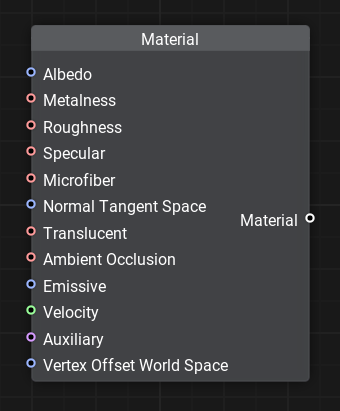Material Node

Description
Generates a material. The set of input ports and supported features, as well as the type of the generated material, depends on the current Common Settings.
Notice
A material graph can contain several Material nodes, but only the one connected to the Final node will be used.
Ports
| Name | Description | |
|---|---|---|
 | Opacity |
Opacity value:
|
 | Opacity Clip Threshold |
Alpha-test opacity threshold value.
|
 | Albedo |
RGB albedo value.
|
 | Opacity (Albedo) |
Albedo intensity multiplier for Decal PBR materials.
|
 | Color |
RGB fragment color value (for Mesh Transparent Unlit materials).
|
 | Metalness |
Metalness value.
|
 | Roughness |
Roughness value.
|
 | Specular |
Specular value.
|
 | Microfiber |
Microfiber value.
|
 | Normal |
Normal vectors data. The Normal Space setting defines how the normal data is treated.
|
 | Translucent |
Translucency value.
|
 | Opacity (Metalness, Specular, Translucent) |
Metalness, Specular, and Translucent intensity multiplier for Decal PBR materials.
|
 | Opacity (Roughness, Microfiber) |
Roughness and Microfiber intensity multiplier for Decal PBR materials.
|
 | Opacity (Normal) |
Normal intensity multiplier for Decal PBR materials.
|
 | Ambient Occlusion |
Ambient occlusion value.
|
 | Emissive |
RGB emission value.
|
 | Velocity |
Velocity vectors defining screen-space pixel offset.
|
 | Auxiliary |
RGBA auxiliary value.
|
 | Auxiliary Clip Threshold |
Opacity threshold value for auxiliary clipping.
|
 | Opacity (Auxiliary) |
Auxiliary intensity multiplier for Decal PBR materials.
|
 | Blur |
Transparent blur value.
|
 | Refraction Screen UV Offset |
Refraction screen-space offset of screen UV coordinates.
|
 | Depth (Offset) |
Custom depth / depth offset value (distance from the camera in the view space), in units.
|
 | Vertex Position / Offset |
Vertex adjustment data.
The Vertex Mode and Vertex Positions Space settings define the vector space and how the data is treated.
Notice
All logic connected to this port is performed on the vertex shader stage. |
 | Tessellation Factor |
Tessellation density factor.
|
 | Tessellation Vertex Offset / Position |
Position of tessellated vertices.
The Vertex Mode and Vertex Positions Space settings define the vector space and how the data is treated.
|
 | PostEffects Clip Threshold |
Opacity threshold value for post effects clipping.
|
 | Shadow Clip Threshold |
Opacity threshold value for shadows clipping.
|
 | Material | Material for the Final node. |
The information on this page is valid for UNIGINE 2.19 SDK.
Last update:
2024-08-16
Help improve this article
Was this article helpful?
(or select a word/phrase and press Ctrl+Enter)